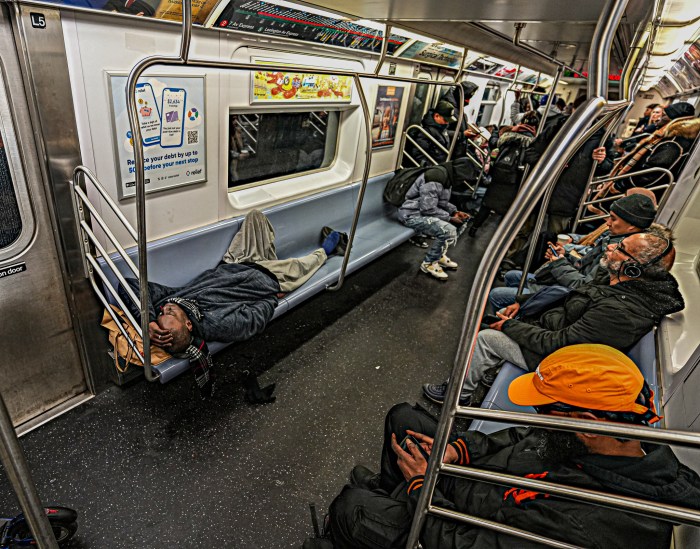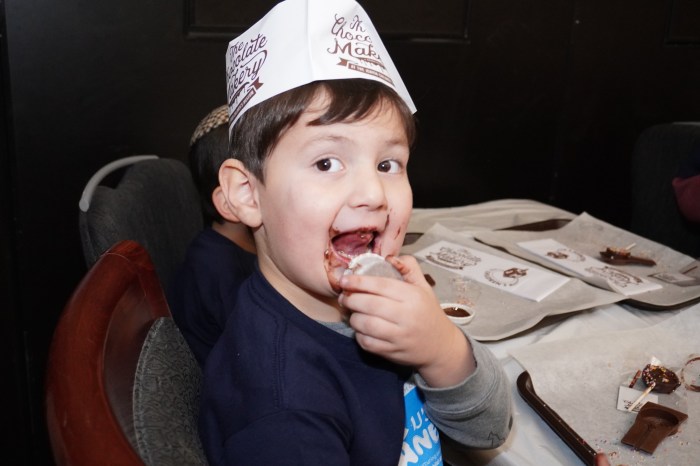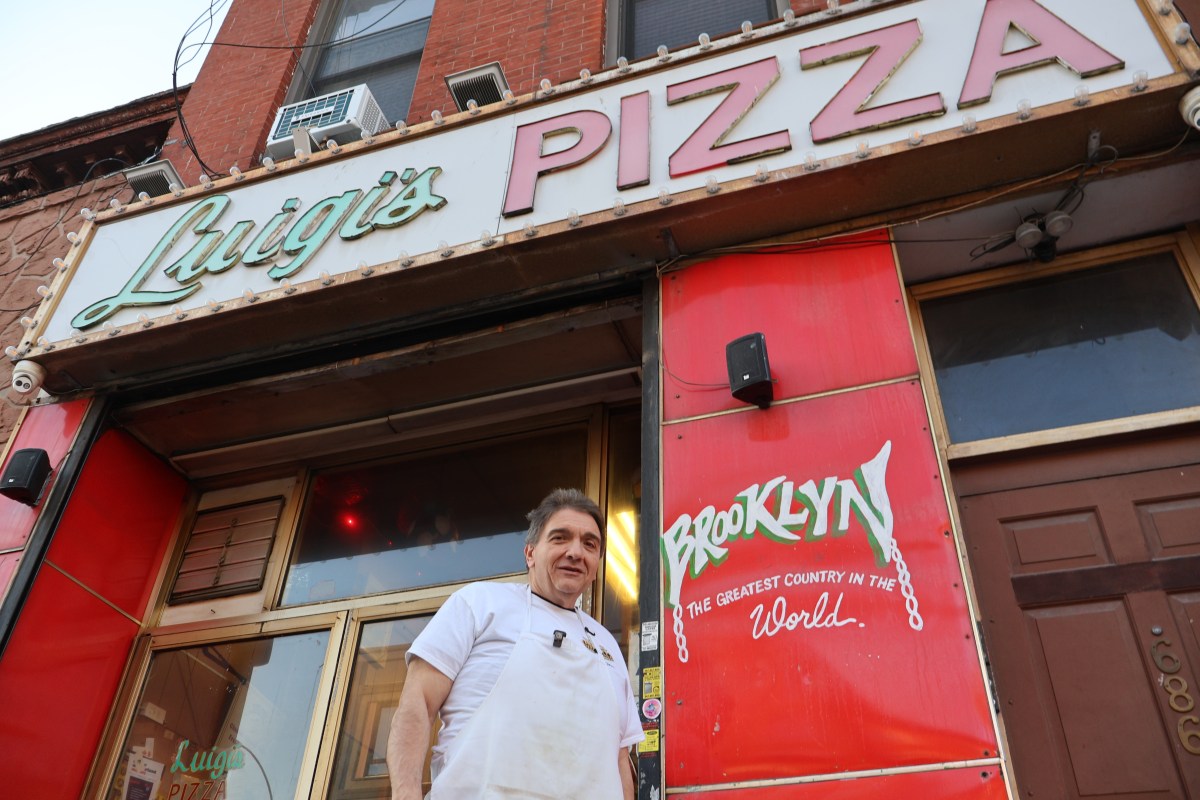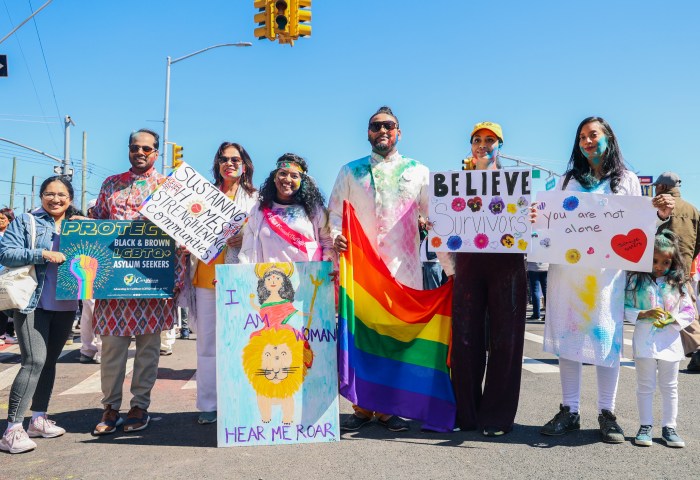
This is part of our NYCurious series, in which we answer your questions about the city. Submit your burning question here.
The 1 train pulls into the 59th Street — Columbus Circle station and guide dog Sunny leads the way into a subway car, resting his head down on an empty orange seat. He isn’t looking to relax after a busy afternoon in Central Park. He’s helping his trainer, Olivia Poff, find a seat of her own.
Sunny, a 1.5-year-old yellow Labrador retriever, is skilled at guiding Poff as she commutes in New York City — distractions and all. Last week, he graduated from the Guide Dog Foundation‘s training program, where he spent 18 months learning to assist individuals who are blind or otherwise visually impaired.

"This is old news for Sunny," Poff, 29, says with a proud smile while the pup she raised helps her seamlessly walk into a crowded subway car.
But, it wasn’t always this way.
Poff has been paired with Sunny since he was about eight weeks old. She’s currently employed with the foundation as a guide dog mobility instructor, but started as one of its many puppy-raising volunteers, responsible with the crucial skill-building of its dogs who will be placed with individuals with disabilities, at no cost to them.
Sunny is the eighth puppy Poff has raised and 25th Guide Dog Foundation pup she’s worked with in the past 10 years.
"It’s been amazing to work with such a sharp, forward-thinking dog," Poff says of Sunny. "His responsiveness and eagerness to play the training game has always been one of my favorite things about him."
She took Sunny’s training to the streets of New York City when he hit five months old, helping him to become acclimated with the many sights, smells and distractions a city commute has to offer.
"New York has a lot of challenges in the amount of noise and how busy it is, but there are also so many perks to training in the city," she says, while Sunny rests near her side. "If you think about a person working out muscles at the gym, they’re going to need a lot of repetition."

That’s exactly what Manhattan has to offer.
Below, Poff shows us what Sunny has learned and fills us in on the intricate guide dog training process.
Who trains guide dogs in New York City?
Well, you do. The Guide Dog Foundation is heavily volunteer-based and accepts applications for its puppy-raising process (you can apply here) year-round. Last year, the foundation’s volunteers spent more than 3.5 million hours helping to serve people with disabilities.
Future guide dogs are raised at the foundation’s nursery on Long Island and placed with home socializing volunteers from 6 and 8 weeks old. From there, dogs are paired with puppy raisers, like Poff, until they’re ready to graduate. In total, dogs typically train from 8 weeks to 14-18 months old.
What does the puppy raiser do?
When Sunny was younger, Poff helped him prep for the future by keeping him well socialized and focusing on basic obedience, like "sit," "stay," "down." His first few weeks involved lots of positive reinforcement (in the form of kibble).
As he progressed, so did his training. "A puppy raiser’s job is to socialize them, teach them impeccable house manners and teach them really good social behaviors when they go out into the world," Poff says. "That means making sure they’re comfortable with all the sights and sounds that exist with our lifestyle."

For Sunny, that meant frequent trips on New York City transit.
Subway exposure
Sunny was first exposed to the subway when he was just a little pup. Too young to walk through the station, Poff sat with him in her lap to help get him used to the vibrations of moving subway cars.
"This was back when he was little enough to be held in my arms — which was a very short period as you can see," she says. "I carried him down, brought his favorite toy and a few pieces of food and just let him listen to the train from my arms. The next step was actually riding the subway."
Poff built up his stamina gradually to get to the point where the bustling platform was no longer a daunting sight. Watching became riding, and riding quickly became guiding.
How does a guide dog assist on the subway?
Short positive exposures when he was young helped Sunny become a commuting pro.
Entering the station, he’ll start by "booping" his nose to the railing of the steps and positioning his body in front of Poff to show her where the stairs begin. While demonstrating, Poff and Sunny are met by glances from passersby and are even approached by an NYPD cop offering assistance.

At the turnstile, Poff swipes her MetroCard and heads through with Sunny behind her. Poff commands Sunny with one-word verbal cues to move him toward the uptown 1 train platform. When the train arrives, commuters step aside to allow Poff and Sunny to enter together: Sunny first, with Poff close behind.
"When I get onto the train, I can ask him to find a seat and he’ll go to the closest empty one, rest his head on it and then I can trail where his head is if I were blind and be able to find a nice spot to take a rest," Poff says.
While the train is in motion, Sunny is tucked between Poff’s legs, his head resting on her feet.
Sunny can take a little break while the train is in motion, because he isn’t a cuddly navigation system. While he can help Poff on and off the train, guide to an open seat and protect from hazards, he can’t figure out how many stops away the grocery store is. It’s up to Poff to listen to the stops and use verbal cues when it’s time to hop off.
"It’s a true team effort between guide dog and handler. It’s my job to give him directions and it’s his job to choose the clearest way to get from point A to point B."

The Guide Dog Foundation trains its pups to fit the needs of each individual who is blind or otherwise visually impaired, but most pups train on the subway, "unless they really, really dislike it," Poff says.
How does Sunny alert his handler of danger?
Sunny uses "intelligent disobedience" to alert of potentially dangerous situations. He’s trained to turn his body in front of his handler to prevent them from, say, walking into traffic or stepping too close to the platform edge. He’d use this technique if he receives the command to turn toward danger. It’s similar to the technique he uses to show Poff where the steps begin or the sidewalk ends.
How does he guide through city streets?
Distractions for a New York City guide dog don’t end with the subway, but crowded blocks and Manhattan traffic are no match for Sunny.

Guide dogs are trained to stop at all changes of elevation, including every curb. When approaching an intersection, Sunny will stop with his front toes in line with the edge of the curb or wheelchair ramp. It’s his handler’s job to then direct him when it’s safe to proceed with the command, "forward."
"If I were the guide dog user, I’d be listening to the flow of traffic," she says crossing the Columbus Circle intersection. "On the cue, ‘forward,’ Sunny is going to move out in front of me. You’ll notice he has about 3/4 his body in front of mine, to give me a second to respond to his movement while he finds the clearest path possible."
Sunny will use his body to communicate, walking slightly in front of Poff to move her to the right or left to clear pedestrian traffic. "When we finish the crossing, he’s going to stop again with his front feet right on the edge of that curb and wait for me to say I’m ready to go forward."
Should the public approach a guide dog?
When Poff and Sunny are out for a stroll, heads turn. A handful of people compliment her on Sunny’s temperament. Four-year-old Mica Haller reaches out for some hugs and kisses after her mother, Mica, asks her permission.
"Whenever you see a guide dog working, the best thing to do is always speak directly to the handler. Don’t engage with the dog at all, unless you have permission to do so. If you wanted to compliment the dog, rather than saying ‘oh my goodness what a really cute dog!’ Go up to the person and say, ‘I think your dog is beautiful, you make a great team.’ "

How does a guide dog get placed with an NYC resident?
The Guide Dog Foundation pairs its dogs with people based on their lifestyle, personalities and general interests, among other criteria. All guide dogs are required to train in several different areas, such as suburban travel, rural sidewalk-less travel, city travel, etc. Not all puppies go on to graduate. Those who aren’t cut out for the guide dog lifestyle may head back for more training, or retire early.
Sunny’s unique personality makes him the perfect fit for New York living.
"He is super smart, super bright and catches on faster with training than any dog I’ve worked with," she says. "I like to say Sunny is very Sunny. He has a bubbly personality and does everything with quite a bit of enthusiasm."
An extra-special pup, Sunny spent more than a year as the "Today" show’s Puppy with a Purpose. His next journey: landing his first job as a facility dog at the Henry Viscardi School at the Viscardi Center on Long Island, where he’ll aid students with disabilities.
Debunking the myths
Olivia Poff, a guide dog mobility instructor with the Guide Dog Foundation, clears up some common misconceptions about how assistance dogs complete their tasks.
- They’re not a cuddly navigation system: Without a clear understanding of how the communication between guide dog and handler works, it can be easy to assume the pup is the one calling the shots. Guide dogs do not take their handlers to exact locations five subway stops away on command. It’s up to the handler to direct, and the guide dog to choose the clearest path.
- Guide dogs don’t know state traffic laws: "People think guide dogs are trained to look at the lights to know when to cross, or that they know when the crossing signal comes on … That’s not true. Somebody who is blind is going to listen to the flow of traffic and when parallel traffic is flowing, there’s not going to be perpendicular traffic coming."
- Guide dogs don’t fully understand the threat of danger: While assistance dogs are trained to alert their handlers of potentially hazardous situations, they are a "plan B" option, Poff says. "He’s just a dog. He doesn’t truly understand the threat of traffic and it is the handler’s job to decide when to cross the street."
- Their harness is not a steering wheel: A handler and their guide dog walk together by aid of the pup’s harness, but it’s not used for commands. Cues between them are both physical and verbal. To alert the dog of a left turn, Poff will use the command "left," not tug or twist on the dog’s harness.


































